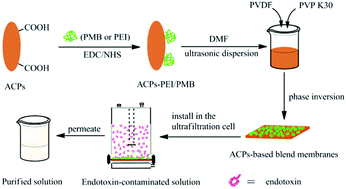Fabrication of membrane absorbers based on amphiphilic carbonaceous derivatives for selective endotoxin clearance
Abstract
In this study, several novel blend membranes based on ligand-immobilized amphiphilic carbonaceous particles (ACPs) and matrix polymer polyvinylidene fluoride (PVDF) were prepared by an immersion phase inversion method. The effects of the ACP content on filtration performance of the membrane were investigated. Endotoxin removal with blend membranes at different pH values and ionic strengths was analyzed and discussed. The results indicated that the use of ACPs not only achieved uniform and stable incorporation of water-soluble ligands into the hydrophobic polymer membrane but also improved its filtration properties, including permeability, strength, hydrophilicity and antifouling ability. The blend membranes with the optimum particle content showed good performances in filtration and were highly effective in removing endotoxins from both buffer and protein solutions under properly chosen conditions. More than 99.8% of endotoxin removal and more than 90% of BSA recovery were achieved when 1 mg L−1 of BSA solution with 116 EU mL−1 of the endotoxin content was treated at pH 4.7. All the above suggested that the carrier-dispersed method described herein was one of the effective methods in constructing functionalized blend membrane absorbers.



 Please wait while we load your content...
Please wait while we load your content...